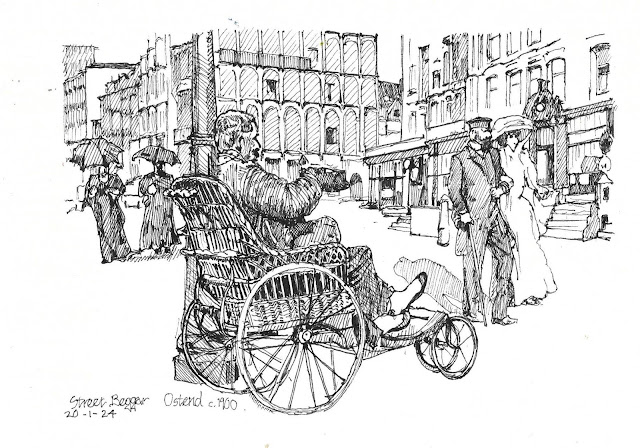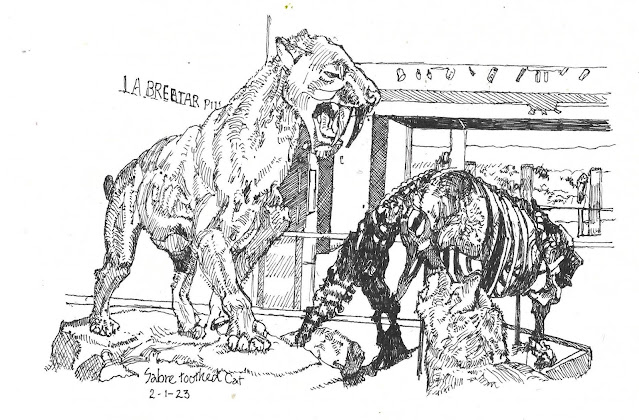What Should I Draw?
Whatever the hell you like! This is supposed to be fun,
remember! Most of us who love drawing aren’t trying to make a living from it.
Yes, alright, a lot of my art is for sale, but I’ve made a lot more money from
selling things that I wanted to draw and paint than I’ve ever done through
commissions. Bearing that in mind then, I would break it down into:-
Draw things that reflect your interests
There’s a reason why the majority of sketches I’ve made so
far in my new sketch book are related to railways, Victoriana/Edwardiana,
London, architecture, and some fulfil several of these criteria. That’s because
I find these things interesting, and if you find something interesting then
you’re not going to mind spending time looking and drawing it.
Draw other artists’ work that you admire and which inspires
you
There’s a lot of benefit to be gained from copying others’
work. In the last couple of years I started copying some of Sir John Tenniel’s
illustrations of Lewis Carroll’s Alice books. I love Victorian engravings I
general and Tenniel’s work in particular. This developed into a challenge to
copy all of his illustrations for the Alice books and that in its turn led me
to copying some of other artists’ later illustrations for the books. I wouldn’t
necessarily say that copying Tenniel has made me sketch more like he did.
However I feel I’ve learned a great deal about how he constructed these
wonderful pieces of work, and its hugely increased my appreciation and
understanding of his work.
Use prompts
When I undertook to make a drawing every day for 365 consecutive days, I found using the prompts from a Facebook group that I joined to be very helpful. Even if you don’t want to join a group, you could use Inktober prompts. Every October since 2009 the public have been challenged to make an ink drawing every day, post it somewhere someone else may see it (from social media to just sticking it on your own fridges.) Every year there’s a series of prompts for each day. You can google these. The challenge of sketching something which fits the prompt is a good one and well worth taking on, as it will lead to you drawing things you would otherwise never thought of drawing.
How long should I spend on a drawing?
On the surface this appears to be a ’how long is a piece of
string?’ question. Thinking about it, though, it’s a fair question. I think I
all depends on the reason why you’re making the drawing.
If you’re drawing in response to a prompt because you’re
trying to make a sketch every day for a specific amount of time, then you’re
limited in the amount of time you want to spend on it. There’s quite a few
quick exercises you can do in a practice session to help build your skills. For
example – pick a subject, then . . .
* Try to draw it in no more than three minutes. This is a
good warm up exercise
* Try to draw it in one continuous line without lifting your
pen/pencil from the page.
* Look at the picture for five minutes then try to draw it with your eyes closed.
* If you’re right handed then try drawing it for five minutes
with your left hand and vice versa if you’re left handed.
The purpose of this sort of exercise isn’t to produce
instant masterpieces but to loosen you up and get you focusing on the bare
essentials. It’s fun too.
Where and what you’re drawing can limit how long you have
to spend on a drawing too. I do as much urban sketching as I can, and to date
I’ve made urban sketches in about 20 different countries. Sketching from
life plein air is for me the ultimate
challenge. It’s at the same time the most challenging and also the most
rewarding kind of sketching. I don’t tend to spend more than an hour on an
urban sketch and this is necessary for a number of reasons. You’re out in
public and this means that people who are sooner or later going to get in your
way. If you’re out in the open then the light conditions are going to change
the longer you spend on the sketch. I suffer from arthritis and sitting, or
worse, standing for long periods becomes painful. Also there are places, for
example metro station platforms, where it’s not a good idea to stay sketching
for long periods of time.
I do sketch from photographs as well. This is a different
challenge to urban sketching. For one thing the camera has already done a lot
of the hard graft for you. The camera has translated a 3 dimensional subject
into a 2 dimensional representation. When you sketch from life you have to do
that yourself. There’s no imperative to sketch particularly quickly when you’re
sketching at home ad I’ve been know to leave a sketch and finish it off later.
As a rough rule of thumb I can do a very detailed sketch in no more than four
hours, which is about how long I spent on the dustman picture.











































